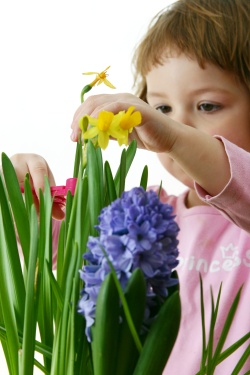Growing a Wildlife Garden
There are many purposes for growing a garden. As a hobby, as a way to save on your food bill, or even just to add appeal to your yard.
Did you ever think about growing a garden that attracts wildlife? Having a garden that attracts butterflies and birds can be a really great learning experience - a way to get to learn about plants and animals all at once.
Plus, it does good to provide a habitat that's suitable for wildlife, especially with the way development of the land has been eating up wildlife's natural habitats. Here is what you will need to grow your wildlife garden.
It is important that you stick to plants, trees, and shrubs that are native to the area you live in. So you'll need to do a little homework about what forestry is native to your area.
Flowers with pollen will attract the birds and the bees. Some good flowers to plant would be crocus or daisy.
This is what will provide the food and shelter for the wildlife that is native to your area.
It will attract the animals and insects to your garden as they will be seeking shelter and food.
Wildlife needs water in their habitat as well. If you don't have a natural water source flowing through your yard, then you'll need to provide this in other ways.
A shallow in-ground pool, a bird bath, or water barrel will provide the water needed to help sustain wildlife in your garden.
Leave a pile of dead wood in a shady area. This provides a habitat for many different creatures. Arrange them architecturally for more appeal.
Partially burying some will help natural moss to grow.
Keeping a compost is not only helpful for growing your plants, but it will also attract wildlife. It makes for a good shelter for many small critters.
Don't forget the bird feeder in your garden. What easier way to attract aviary wildlife to your garden than with a bird feeder?
Keep it out year round because there will be critters foraging for food in the cold winter months.
Avoid pesticides which will be dangerous to wildlife. Using natural pesticides to protect your plants is the best way to go.
When planting you will want to keep a vertical layer. This means having many different layers of plants.
Plants low to the ground, shrubs a little higher up, and trees including fruit trees.
This will attract many different kinds of wildlife to your garden, and it will give many different homes for many different types of wildlife.
Grow a patch of your lawn longer than the rest to provide hibernation for many smaller animals. And remember, you don't need to be too neat.
Leaving some fallen fruit on the ground will help foraging woodland creatures find something to eat when they need it.
Your garden can still look pretty with a few piles of dead leaves or fallen fruit on the ground.
Remember, if you build it they will come. If you build an animal habitat, then the animals will come to your yard.
So get out your bird watching gear and your camera and be ready to snap some pictures of the beautiful wildlife that will be visiting your yard on a daily basis.
Don't forget to look closely for the smallest of wildlife that will be visiting your wildlife garden.
How to Attract Wildlife to Your Garden
As part of an ecosystem it's important to help out the native wildlife in your area. To do this you will want to help provide food and shelter for them.
Your garden is one way to attract wildlife to your yard and help provide them with a place they too can call home.
Allowing us all to live in harmony is important in supporting an ecosystem. Providing a water source of some sort is a definite must-have as a habitat for wildlife.
Beyond that there are several different kinds of plants you can plant which will attract the wildlife you desire to have in your yard.
Here are the things you should plant in your garden to attract and keep wildlife in your garden.
1. Goldenrod - Goldenrod is perfect for an autumn garden. It will attract many different kinds of creatures who will protect your garden like spiders, and also birds who will feed on the seeds and the insects you don't want in your garden.
2. Aster - These plants thrive in prairie, meadow, pasture, roadside, and woodland environments. They bloom in both spring and fall.
They attract bees and butterflies with their abundant pollen and nectar, making them a wonderful choice for any wildlife garden.
3. Sunflower - The plants attract many birds and other wildlife with all of their nectar and pollen. They can be planted as both perennials and annuals.
4. Joe Pye - If you want a pollinator garden, then you want Joe Pye in your garden.
With the plentiful nectar and pollen it produces, you will be attracting plenty of birds and bees into your garden to pollenate.
Joe Pye is one of the best native alternatives for invasive butterfly bush.
5. Morning glory - Research this one carefully and only plant what's native to your area, or you'll regret ever planting it.
They can become very invasive in your garden. Check with the native plant society in your state for guidance.
6. Sedges - Planting sedges is twofold in what it does for the environment.
Being a plant on the threatened list in the U.S., planting it in your garden will protect them while also providing for wildlife.
Sedges work in grassland, prairie, and woodland environments. Grasses and sedges are an essential element for wildlife in our gardens.
7. Honeysuckle - Just not the Japanese honeysuckle! Do plenty of research to ensure you are planting honeysuckle that is native to your area because there are several very invasive alien honeysuckles wreaking havoc in many ecosystems.
Native honeysuckle is wonderful for hummingbirds and butterflies.
8. Lupine - You can save several endangered butterflies, such as the Karner blue, by planting lupine. Many of these endangered butterflies rely on lupine for survival.
Check with your state native plant society to determine which species will be most appropriate for your garden.
9. Violets - Who doesn't love a good violet? Many groups of butterflies also becoming endangered, like Fritillaries, thrive on violets. These are great plants for adding early spring color to your garden.
10. Geraniums - Find a native species that will grow best in your location. Do not go with a hanging basket. Plant them and attract many different birds and insects into your garden.
These are all great plants to have growing throughout your garden to help support our eco system.
You can even use them to help protect the rest of your garden from unwanted predators. Plus, you will get to see so much beauty in the nature of your garden.
Check with your local plant society or garden center for the best species of each plant that is native to your area so you don't end up creating more of a problem.
How did you like this post? If you found this article helpful to you, you may want to share it with others by clicking the social networking buttons – Thank You!
Cheers, Helene Malmsio
Related Reading: https://www.discoveryhub.net/kids-gardening-tips.html
Join in and write your own page! It's easy to do. How? Simply click here to return to Gardening.

"Power Tips" magazine is back!
You Get A Free Complete Self Help Report delivered to your email box every edition, plus you get a free PLR article and other great gifts!
SUBSCRIBE BELOW ... I promise you will want to USE what you learn!
I really want to know what you think of this site, this page, and to hear your tips or suggestions about it.
So please share your story or simply add a Comment in the comment box.
If you feel that the information on this page has been useful to you please give it a Like or share it with your friends - thanks!!
"You are a life Saver!!
I recently discovered this site and I can tell you that my life has not been the same. I now come here EVERYDAY and spend at least 1 hour.
I used to spend that time browsing online fashion and beauty
magazine which just means that I spend more. Now I have replaced that
habit with coming here.
In future I will think about contributing articles as well. Thank you! Thank you!! Thank you!!! and God bless"
Contact Us | About Us | Terms of Use | Privacy Policy | FAQ | Testimonials
Amazon and the Amazon logo are trademarks of Amazon.com, Inc. or its affiliates. As an Amazon Associate I earn from qualifying purchases. Product prices and availability are accurate as of the date/time
indicated and are subject to change. Any price and availability
information displayed on [relevant Amazon Site(s), as applicable] at the
time of purchase will apply to the purchase of this product.









